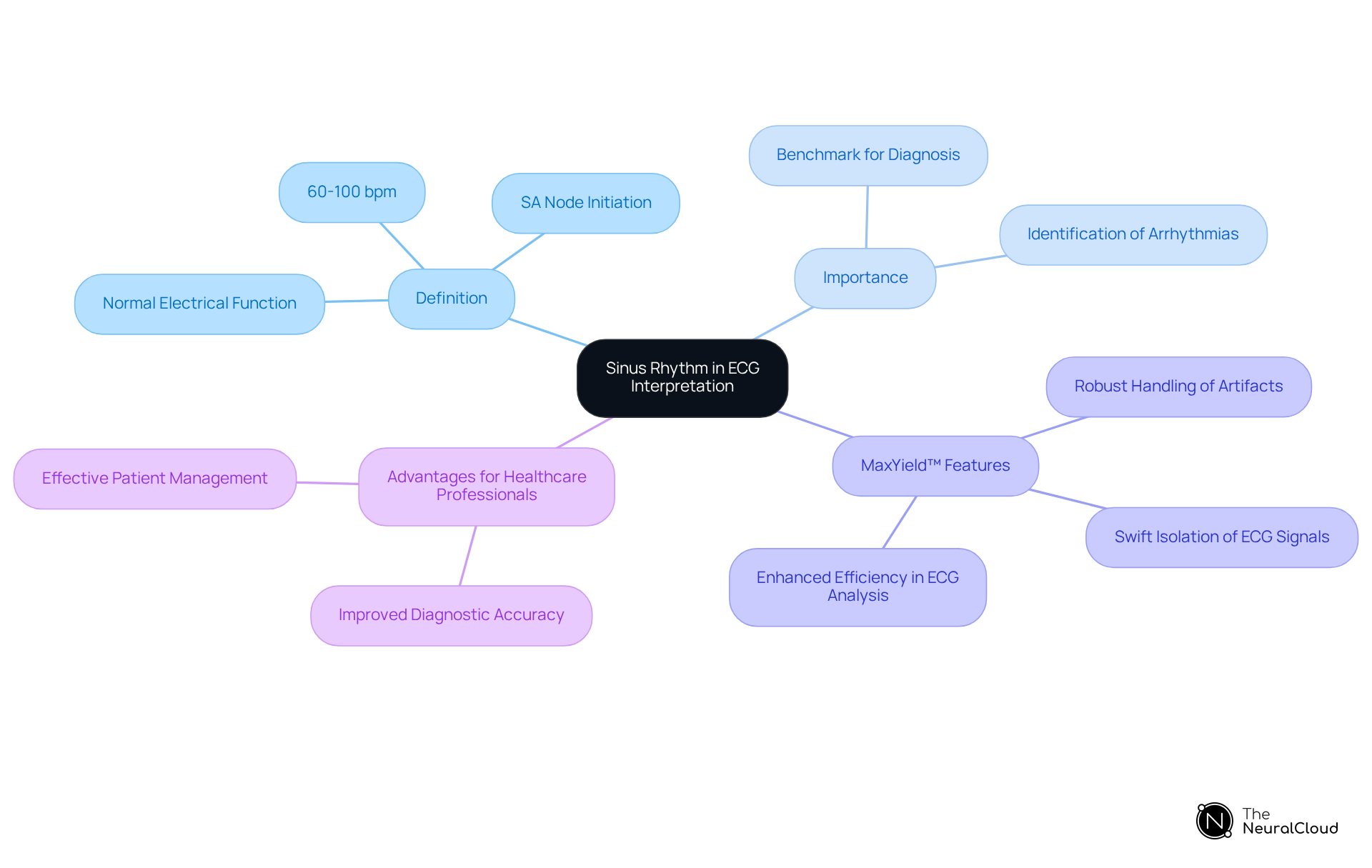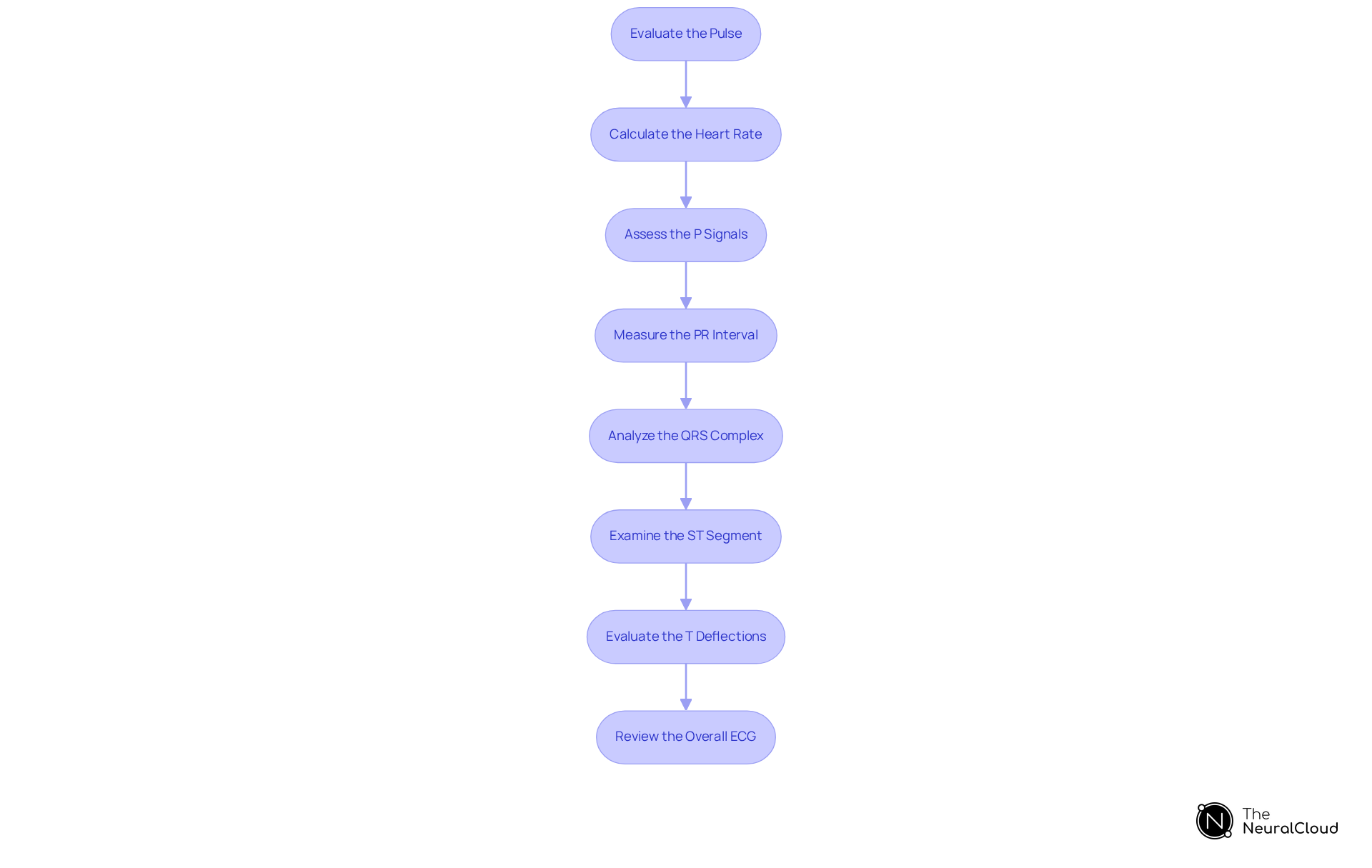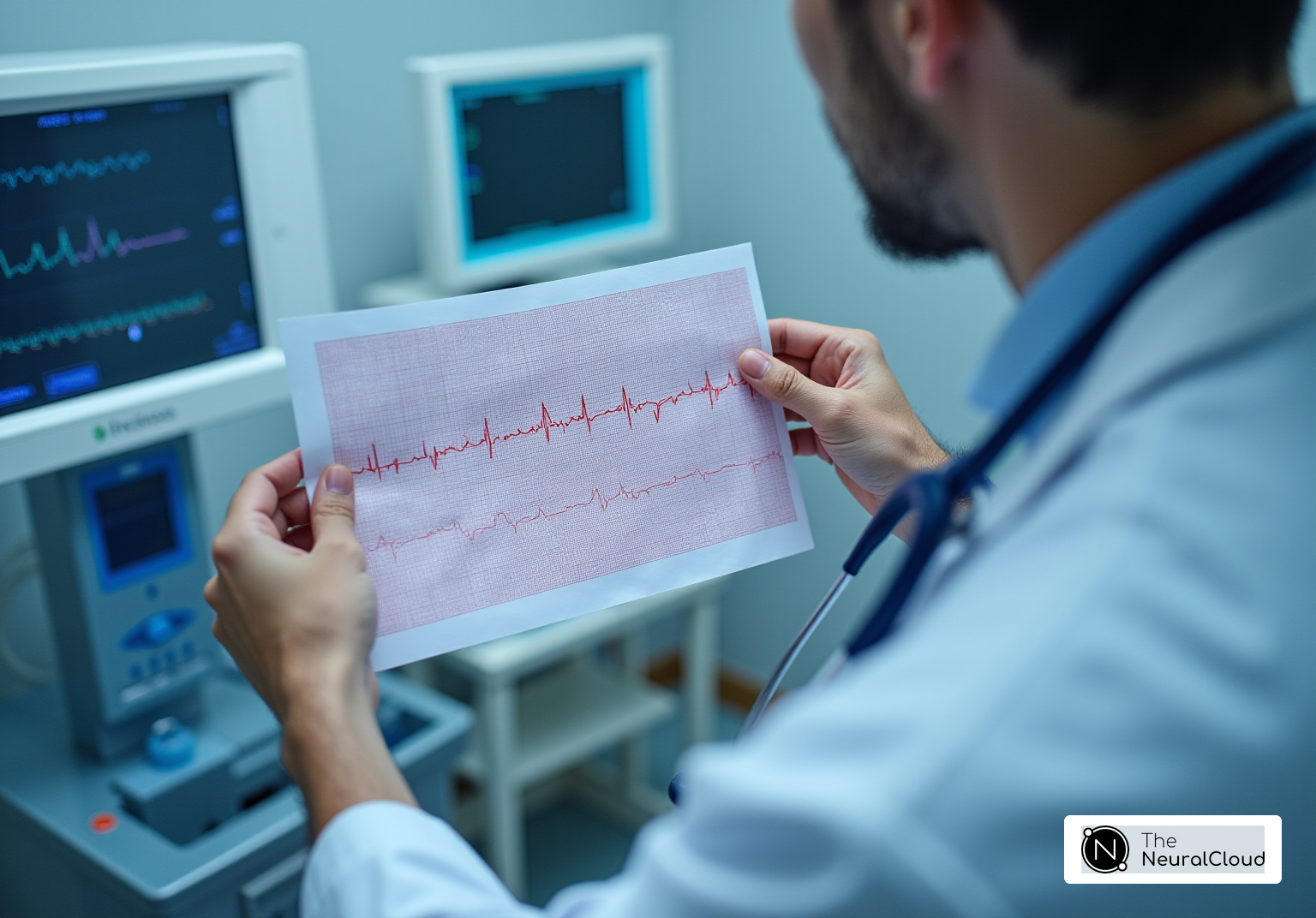Overview
The article emphasizes the significance of mastering sinus rhythm ECG interpretation and presents a step-by-step guide designed to enhance diagnostic accuracy for cardiac conditions. Understanding sinus rhythm is crucial for detecting irregularities that could signal serious health concerns. This is supported by a systematic approach to ECG analysis, complemented by advanced tools such as the MaxYield™ platform. These resources assist healthcare professionals in navigating common challenges associated with ECG interpretation.
Introduction
Understanding the intricacies of sinus rhythm is essential for healthcare professionals, as it serves as the foundation for accurate ECG interpretation. This article explores the challenges faced in ECG analysis, particularly the significance of recognizing sinus rhythm patterns. It provides a comprehensive step-by-step guide that enhances diagnostic precision and patient care. Additionally, common issues such as lead misplacement and artifact interference are discussed, prompting the question: how can clinicians ensure accurate and effective ECG interpretation?
Define Sinus Rhythm and Its Importance in ECG Interpretation
Sinus rhythm ECG indicates the heart's normal electrical function, which is initiated by the sinoatrial (SA) node, the heart's natural pacemaker. In a healthy individual, this pattern is characterized by a heart rate ranging from 60 to 100 beats per minute, with consistent intervals between beats. The representation of normal cardiac activity on a sinus rhythm ECG showcases distinct P waves preceding each QRS complex, indicating proper atrial depolarization followed by ventricular depolarization. Understanding cardiac patterns is crucial for healthcare professionals, as it serves as a benchmark for diagnosing various cardiac conditions. Irregularities in this pattern may signal underlying issues such as arrhythmias or other cardiac disorders, making accurate identification vital for effective patient management. Statistics indicate that the prevalence of arrhythmias in the general population ranges from 1.5% to 5%, highlighting the importance of recognizing deviations in heartbeats. Leading cardiologists emphasize that a thorough understanding of heart patterns can significantly enhance diagnostic accuracy, ultimately improving patient outcomes. The latest cardiology guidelines advocate for meticulous identification of sinus rhythm ECG patterns as an essential skill for clinicians, underscoring its significance in comprehensive cardiac evaluation.
The MaxYield™ platform from Neural Cloud Solutions addresses the challenges faced in ECG analysis. It enables healthcare professionals to quickly isolate ECG signals, even in recordings affected by baseline wander and muscle artifacts. This not only streamlines the ECG analysis process but also tackles the issues posed by physiological variability and signal artifacts. Consequently, critical data is accurately identified and labeled, resulting in improved diagnostic yield.
Key Features of MaxYield™:
- Swift isolation of ECG signals
- Enhanced efficiency in ECG analysis
- Robust handling of baseline wander and muscle artifacts
Advantages for Healthcare Professionals:
- Improved diagnostic accuracy
- Effective management of patient care
- Comprehensive understanding of cardiac conditions
Incorporating the MaxYield™ platform into clinical practice empowers healthcare professionals to navigate the complexities of ECG analysis with greater confidence and precision.

Follow a Step-by-Step Method for ECG Interpretation
To interpret an ECG effectively, follow these steps, utilizing the advanced capabilities of Neural Cloud Solutions' MaxYield™ platform to enhance clarity and efficiency:
- Evaluate the Pulse: Identify whether the pulse is consistent or inconsistent by gauging the intervals between R peaks. A regular rhythm will exhibit consistent intervals, while an irregular rhythm will show variability.
- Calculate the Heart Rate: Estimate the heart rate using the formula (300 divided by the number of large squares between R peaks). Alternatively, count the number of R peaks in a 6-second strip and multiply by 10.
- Assess the P Signals: Verify the existence of P signals prior to each QRS complex, which suggests that the sinus rhythm ECG is likely sinusoidal in nature. Evaluate the structure of the P signals for any irregularities.
- Measure the PR Interval: The PR interval should range between 120 to 200 milliseconds. A prolonged PR interval may indicate a first-degree heart block.
- Analyze the QRS Complex: The QRS duration should be less than 120 milliseconds. A wide QRS may suggest a bundle branch block or other conduction abnormalities.
- Examine the ST Segment: Look for elevation or depression in the ST segment, which can indicate ischemia or infarction.
- Evaluate the T Deflections: T deflections should be upright in most leads. Inversion or flattening can indicate underlying cardiac issues.
- Review the Overall ECG: Finally, consider the overall picture of the sinus rhythm ECG, including any patterns or trends that may indicate specific conditions. Document your findings clearly for further analysis or discussion with colleagues.
By leveraging the automated labeling and analysis features of MaxYield™, including the precise mapping of PQRST patterns and the automation of durations and intervals, healthcare professionals can enhance their ECG interpretation process. This ensures accurate assessments even amidst physiological variability and noise.

Troubleshoot Common ECG Interpretation Challenges
When interpreting sinus rhythm ECGs, clinicians may face various challenges. Common issues include lead misplacement, artifact interference, poor signal quality, misinterpretation of normal variants, overreliance on automated interpretations, and the need for continuous learning. Addressing these challenges is crucial for accurate analysis of sinus rhythm ECG.
Lead Misplacement: Incorrect lead placement can significantly distort ECG readings, leading to misinterpretation. Studies indicate that 2% of over 11,000 ECGs analyzed presented lead placement interchange. Always double-check lead positions before recording the sinus rhythm ECG. If abnormalities are noted on the sinus rhythm ECG, consider re-evaluating the lead placements since misplacement can simulate conditions like myocardial infarction.
Artifact Interference: Artifacts can obscure true cardiac signals, often caused by patient movement or poor electrode contact. Ensure that the patient is relaxed and minimize movement during the recording of the sinus rhythm ECG. If artifacts are present, consider repeating the ECG under optimal conditions. For instance, a study highlighted that 38% of electrophysiologists misdiagnosed ventricular tachycardia due to artifacts in the sinus rhythm ECG, underscoring the need for careful monitoring.
Poor Signal Quality: Low-quality signals can arise from inadequate skin preparation or poor electrode adhesion. Regular evaluation of electrode quality is essential, as poor contact can lead to failures in sinus rhythm ECG readings. Neural Cloud Solutions' MaxYield™ platform addresses this challenge with advanced noise filtering and wave recognition, ensuring that the signals captured are clean and reliable. Techniques such as using alcohol prep pads can for sinus rhythm ECG. Additionally, the platform's P, QRS, and T Wave highlighting features further improve signal clarity and interpretation accuracy.
Misinterpretation of Normal Variants: Some normal variants can mimic pathology. Familiarize yourself with common normal variants to avoid unnecessary alarm. For example, sinus arrhythmia is common in young, healthy individuals and should not be mistaken for a pathological condition. Understanding these nuances can prevent misdiagnosis and improve patient care by accurately interpreting sinus rhythm ECG.
Overreliance on Automated Interpretations: While automated ECG interpretation tools can be helpful, they are not infallible. Automated systems have shown a sensitivity of 57% and a specificity of practically 100% in detecting lead interchange. Always review the sinus rhythm ECG manually to confirm findings and prevent missing subtle abnormalities. MaxYield™ enhances this process by automating repetitive tasks and providing a clear, beat-by-beat data wall for better analysis.
Continuous Learning: Stay updated with the latest guidelines and research in ECG interpretation. Regularly participate in training sessions and workshops to refine your skills and knowledge. Additionally, regular software updates and routine calibration of ECG machines are essential to prevent glitches and calibration errors. Engaging with experts in the field can provide valuable insights into troubleshooting common issues related to sinus rhythm ECG and enhance overall diagnostic accuracy.

Conclusion
Mastering sinus rhythm ECG interpretation is vital for healthcare professionals, serving as a foundation for accurate cardiac assessment. This guide outlines the essential components that define sinus rhythm and underscores its clinical significance in diagnosing various heart conditions. By employing systematic methodologies, clinicians can enhance their ability to interpret ECG readings effectively, ensuring improved patient management.
Key insights discussed include:
- The characteristics of sinus rhythm
- A step-by-step approach to ECG interpretation
- Common challenges faced during the process
Advanced tools like the MaxYield™ platform play a crucial role in streamlining ECG analysis. This platform mitigates issues such as lead misplacement and signal artifacts, enhancing the overall accuracy of interpretations. Moreover, the importance of continuous learning and manual verification of automated interpretations is emphasized, ensuring that clinicians remain adept at recognizing both normal variants and pathological conditions.
Ultimately, the ability to accurately interpret sinus rhythm ECGs significantly impacts patient care and outcomes. By integrating the methodologies and technologies outlined in this guide, healthcare professionals can enhance their diagnostic accuracy and confidence. Engaging in ongoing education and utilizing advanced tools will not only address current challenges in ECG interpretation but also empower clinicians to provide the highest standard of care in cardiac health.
Frequently Asked Questions
What is sinus rhythm in the context of ECG interpretation?
Sinus rhythm indicates the heart's normal electrical function, initiated by the sinoatrial (SA) node, characterized by a heart rate of 60 to 100 beats per minute and consistent intervals between beats.
What are the key features of a sinus rhythm ECG?
A sinus rhythm ECG showcases distinct P waves preceding each QRS complex, indicating proper atrial depolarization followed by ventricular depolarization.
Why is understanding sinus rhythm important for healthcare professionals?
Understanding sinus rhythm is crucial for diagnosing various cardiac conditions, as irregularities may signal underlying issues such as arrhythmias or other cardiac disorders.
What is the prevalence of arrhythmias in the general population?
The prevalence of arrhythmias in the general population ranges from 1.5% to 5%.
How can a thorough understanding of heart patterns improve patient outcomes?
A comprehensive understanding of heart patterns can enhance diagnostic accuracy, ultimately improving patient outcomes.
What does the latest cardiology guidelines emphasize regarding ECG analysis?
The latest cardiology guidelines advocate for meticulous identification of sinus rhythm ECG patterns as an essential skill for clinicians.
What is the MaxYield™ platform and how does it assist in ECG analysis?
The MaxYield™ platform addresses challenges in ECG analysis by enabling quick isolation of ECG signals, even in recordings affected by baseline wander and muscle artifacts.
What are the key features of the MaxYield™ platform?
Key features include swift isolation of ECG signals, enhanced efficiency in ECG analysis, and robust handling of baseline wander and muscle artifacts.
What advantages does the MaxYield™ platform provide for healthcare professionals?
Advantages include improved diagnostic accuracy, effective management of patient care, and a comprehensive understanding of cardiac conditions.
How does incorporating the MaxYield™ platform into clinical practice benefit healthcare professionals?
It empowers healthcare professionals to navigate the complexities of ECG analysis with greater confidence and precision.






